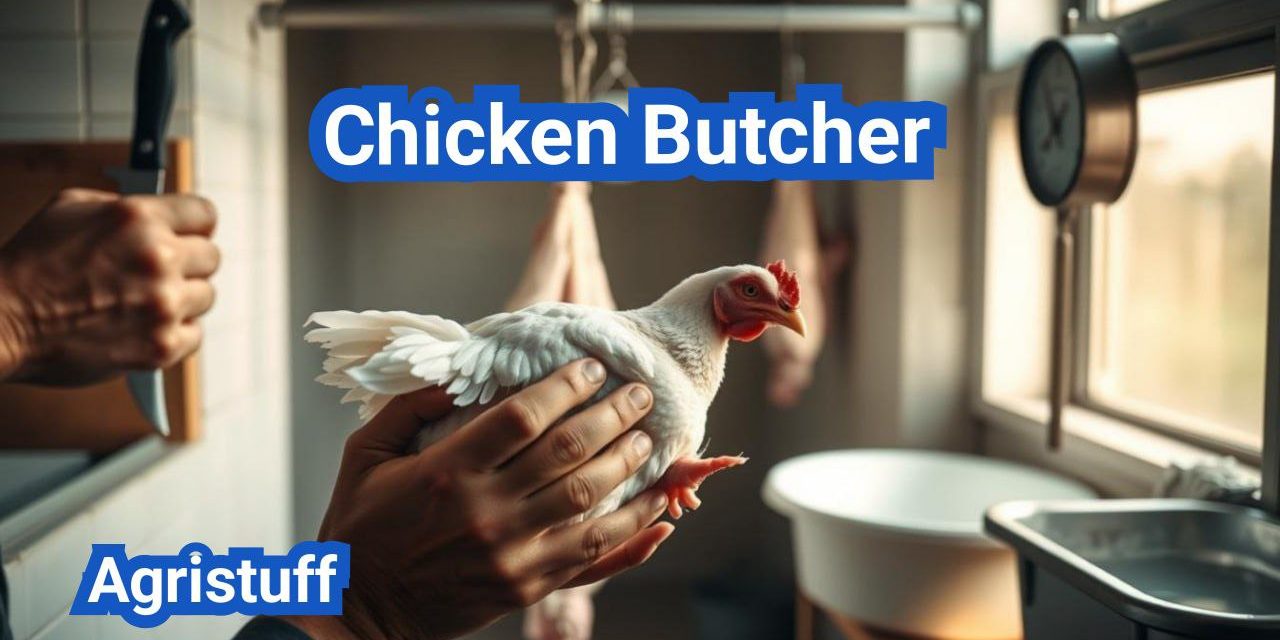Raising poultry for meat can be a rewarding experience, but it requires careful consideration of humane processing methods.
According to Kayla Lobermeier, the most humane way to kill a chicken ( Chicken Butcher ) is debated, but using a culling cone and slicing the carotid arteries is considered one of the most humane methods.
Processing poultry at home requires the right equipment and techniques to ensure a humane and efficient process.
Key Takeaways
- Humane processing methods are essential for backyard chicken processing.
- Using a culling cone and slicing the carotid arteries is a humane slaughter method.
- Poultry processing equipment is necessary for efficient processing.
- Backyard chicken processing requires careful planning and execution.
- Humane treatment of poultry is crucial for a successful processing experience.
Understanding Home Poultry Processing
You’re not alone in considering processing chickens at home; many find it a viable option for ensuring the quality and humane treatment of their poultry. Home poultry processing involves several key considerations, from the benefits of controlling your meat’s quality to understanding the legal and ethical implications of such practices.
Benefits of Processing Your Own Chickens
Processing your own chickens at home offers several key advantages. It allows for control over the quality of the meat, ensuring that it is handled and processed in a manner that aligns with your standards. Additionally, home processing can be more cost-effective in the long run and provides an opportunity to develop a deeper understanding of where your food comes from.
As noted by experts, “having control over the processing of your chickens means you can ensure they are treated humanely and with respect.” This not only enhances the quality of the meat but also contributes to a more ethical food production process.
Legal Considerations for Home Butchering
Before embarking on home poultry processing, it’s crucial to understand the legal considerations. Regulations regarding home butchering vary significantly by location, with some areas having specific laws governing the slaughter and processing of poultry at home.
- Check local laws and regulations regarding home poultry processing.
- Understand any permits or licenses required for home butchering.
- Familiarize yourself with health and safety guidelines.
Ensuring compliance with these regulations is not only legally necessary but also important for maintaining a safe and healthy environment for food production.
Ethical Aspects of Home Poultry Slaughter
The ethical aspects of home poultry slaughter are multifaceted, involving considerations of animal welfare, personal values, and the broader implications of food production choices. It’s essential to approach poultry slaughter in a manner that is humane and respectful, ensuring that the process is as stress-free as possible for the animals.
“The way we treat animals reflects our values as a society.”
By prioritizing humane treatment and ethical practices in home poultry processing, individuals can contribute to a more sustainable and compassionate food system.
Mental Preparation for First-Time Chicken Butchers

Before you begin butchering chickens, it’s crucial to understand the mental preparation required for this task. Processing poultry at home for the first time can be a daunting experience, both physically and emotionally.
Acknowledging the Emotional Aspects
The act of slaughtering animals can have a significant emotional impact on individuals, especially those who are doing it for the first time. It’s essential to acknowledge these feelings rather than suppressing them. As one source poignantly puts it,
“death is ugly and awful, but something dies every day so you and I can live.”
This perspective can help individuals come to terms with the reality of the process.
The emotional aspects of chicken butchering include:
- Confronting the reality of taking a life
- Dealing with the messiness of the process
- Managing stress and anxiety related to the task
Developing the Right Mindset
To develop the right mindset, first-time chicken butchers should focus on the reasons behind their decision to process their own poultry. Whether it’s for sustainability, self-sufficiency, or quality control, understanding the motivations can help in preparing mentally.
Key strategies for developing the right mindset include:
- Educating oneself about the process and its significance
- Preparing for the task by visualizing the steps involved
- Focusing on the benefits of home butchering, such as freshness and control over the process
Respecting the Process and the Animal
Respecting the animal and the process is crucial for a humane and dignified experience. This involves understanding the importance of quick and painless methods, as well as appreciating the life of the animal being processed.
By respecting the process and the animal, individuals can approach the task with a clearer conscience and a more positive outlook. This mindset not only makes the experience less daunting but also more meaningful.
Best Chicken Breeds for Meat Production
For those looking to process chickens at home, understanding the best breeds for meat production is essential. The right breed can significantly impact the quality and quantity of meat produced.
Cornish Cross and Other Commercial Meat Breeds
Cornish Cross chickens are one of the most popular breeds for meat production due to their fast growth rate and large breast meat. They are a hybrid breed, specifically developed for their meat production capabilities.
Key characteristics of Cornish Cross include:
- Fast growth rate: They reach market weight in as little as 6-8 weeks.
- Large breast meat: Ideal for those looking to maximize breast meat production.
- Efficient feed conversion: They convert feed into meat efficiently, making them a cost-effective choice.
Other commercial meat breeds include Ross 308 and Cobb 500, which also offer excellent growth rates and meat quality.
Dual-Purpose Heritage Breeds
While commercial breeds like Cornish Cross are optimized for meat, dual-purpose heritage breeds offer the advantage of being suitable for both meat and egg production. These breeds are often preferred by backyard chicken keepers for their versatility and hardiness.
Popular dual-purpose heritage breeds include:
| Breed | Growth Rate | Egg Production |
|---|---|---|
| Rhode Island Red | Moderate | High |
| Barred Plymouth Rock | Moderate | High |
| Wyandotte | Moderate | Good |
Optimal Age and Weight for Butchering
The optimal age and weight for butchering vary depending on the breed and intended use. For commercial breeds like Cornish Cross, the optimal age is typically between 6 to 8 weeks, when they reach 4-5 lbs.
“The ideal butchering age for heritage breeds can be slightly older, often between 12 to 16 weeks, as they grow more slowly. The weight can vary but is typically around 6-8 lbs for a well-grown bird.”
Understanding the characteristics of different breeds and their optimal butchering age and weight is crucial for successful meat production. Whether you choose a commercial breed for fast growth or a heritage breed for its dual-purpose capabilities, being informed will help you achieve your goals.
Essential Chicken Butchering Equipment

To successfully butcher chickens at home, it’s essential to be equipped with the proper tools and equipment. This not only ensures the process is carried out efficiently but also safely and humanely.
Basic Tools: Sharp Knives and Poultry Shears
The foundation of any chicken butchering setup includes sharp knives and poultry shears. A sharp boning knife is crucial for making precise cuts around bones, while poultry shears are used for cutting through bones and tougher meat. Investing in high-quality, rust-resistant tools is advisable.
Other basic tools include a cutting board for preparing the chicken, a pair of gloves for protecting your hands, and a waterproof apron to keep your clothing clean and dry.
Specialized Poultry Processing Equipment
For those who plan to process chickens regularly, investing in specialized equipment can be beneficial. This includes a chicken plucker for removing feathers, a scalding tank for loosening feathers before plucking, and an evisceration table for safely removing internal organs.
DIY Alternatives for Budget Processing
Not everyone needs or can afford specialized equipment. For budget-friendly processing, consider DIY alternatives. For example, a large barrel or tub can serve as a makeshift scalding tank, and a drill with a rubber attachment can be used as a simple chicken plucker.
| Equipment | Purpose | DIY Alternative |
|---|---|---|
| Sharp Boning Knife | Making precise cuts around bones | N/A |
| Poultry Shears | Cutting through bones and tough meat | Heavy-duty kitchen shears |
| Scalding Tank | Loosening feathers before plucking | Large barrel or tub with hot water |
| Chicken Plucker | Removing feathers from the chicken | Drill with rubber attachment |
By understanding the essential equipment needed for chicken butchering and exploring DIY alternatives, individuals can efficiently process chickens at home, ensuring a safe and humane process.
The Chicken Butcher Diagram: Understanding Poultry Anatomy
To process chickens effectively, one must first understand their anatomical structure. Poultry anatomy is complex, involving various organs and systems that need to be handled carefully during the butchering process.
Key Anatomical Features for Butchering
Several anatomical features are crucial for chicken butchers to understand. These include the skeletal system, major organs, and the layout of the circulatory system. Knowing these features helps in identifying the best points for cutting and ensures a humane slaughter.
Major Anatomical Landmarks:
- The jugular vein and carotid artery are critical for bleeding out the bird.
- The trachea and esophagus are key structures to be aware of during evisceration.
- The breastbone and ribcage provide important references for cutting.
Visual Guide to Chicken Cuts
Understanding the different cuts of chicken is essential for maximizing the value of the bird. A visual guide can help illustrate how to break down a chicken into its various components.
| Cut | Description |
|---|---|
| Breast | The pectoral muscles, often sold boneless or bone-in. |
| Thighs | The dark meat from the upper leg, known for its rich flavor. |
| Wings | Used for various dishes, from buffalo wings to chicken soup. |
| Drumsticks | The lower leg portion, popular for grilling or frying. |
Identifying Critical Points for Humane Processing
Humane processing is a critical aspect of chicken butchering, ensuring that the bird is treated with respect and minimal suffering. Identifying the correct points for slaughter and bleeding is vital.
“The key to humane slaughter is a quick and precise cut to the major blood vessels, ensuring rapid bleeding and minimizing distress.”
By understanding and applying knowledge of poultry anatomy, chicken butchers can ensure a more efficient, humane, and respectful process.
Setting Up Your Backyard Chicken Processing Station

A well-organized backyard chicken processing station is essential for safe and effective poultry processing. This setup not only ensures a smooth workflow but also maintains the highest standards of sanitation and food safety.
Creating an Efficient Workflow
To create an efficient workflow, it’s crucial to designate specific areas for different stages of chicken processing. This includes separate zones for slaughtering, scalding, plucking, and evisceration. By organizing your workspace in this manner, you can significantly reduce processing time and minimize the risk of cross-contamination.
Key considerations for an efficient workflow include:
- Easy access to water sources for cleaning
- Adequate lighting for detailed tasks
- Proper ventilation to remove unpleasant odors and moisture
- Non-slip surfaces to prevent accidents
Sanitation and Food Safety Considerations
Maintaining a clean and sanitary environment is paramount in backyard chicken processing. This involves regular cleaning and disinfection of all equipment and surfaces that come into contact with the chickens or their products.
| Sanitation Task | Frequency | Recommended Method |
|---|---|---|
| Cleaning equipment | After each use | Hot soapy water and sanitizer |
| Disinfecting surfaces | Daily | 1:10 bleach solution |
| Waste disposal | After each processing session | Sealed bags or composting |
Waste Management Planning
Effective waste management is critical for maintaining a clean and environmentally friendly backyard chicken processing station. This includes proper disposal of feathers, blood, and internal organs.
Consider the following waste management strategies:
- Composting organic waste to create nutrient-rich fertilizer
- Using sealed bags for disposing of non-compostable waste
- Implementing a rendering or proper disposal method for inedible parts
By carefully planning your backyard chicken processing station, you can ensure a safe, efficient, and sustainable process that yields high-quality poultry products.
Preparing Chickens Before Slaughter

Before slaughtering chickens, it’s crucial to prepare them properly to ensure a humane and efficient process. Proper preparation not only enhances the quality of the meat but also simplifies the processing procedure.
Pre-Butchering Care and Feeding
One critical aspect of preparing chickens for slaughter is their pre-butchering care and feeding. Withholding feed from chickens 12 hours before butchering is recommended to make the process cleaner. This practice reduces the amount of fecal material in the intestines, minimizing the risk of contamination during evisceration.
Ensuring access to clean water is also vital until the time of processing. Dehydration can lead to decreased meat quality, so it’s essential to manage the chickens’ environment carefully in the days leading up to slaughter.
Humane Handling Techniques
Humane handling techniques are essential for reducing stress and ensuring the welfare of the chickens. Gentle, careful handling minimizes the risk of injury to both the birds and the handlers. It’s crucial to move slowly and deliberately when handling chickens to avoid startling them.
Using appropriate equipment, such as catching hooks or crates designed for poultry, can help in handling the birds safely and humanely. Training on humane handling practices is beneficial for anyone involved in the process.
Reducing Stress in Birds
Reducing stress in birds before slaughter is vital for improving meat quality. Stress can lead to a range of negative outcomes, including decreased tenderness and an increased risk of disease. Minimizing changes in the birds’ environment and maintaining a calm atmosphere can help reduce stress.
“Minimizing stress in the pre-slaughter period is crucial for maintaining the quality of the meat,” says an expert in poultry processing.
By implementing humane handling techniques and providing appropriate pre-butchering care, farmers can significantly reduce stress in their flocks, leading to better outcomes for both the animals and the final product.
Humane Chicken Slaughter Methods

When it comes to processing chickens at home, understanding humane slaughter methods is essential. Humane slaughter is not only an ethical consideration but also crucial for producing high-quality meat.
“The most humane way to slaughter a chicken is one that results in the quickest and most painless death possible,” according to experienced poultry processors. Two methods that are often discussed in the context of humane chicken slaughter are the use of a chicken butchering cone and the broomstick method.
Using a Chicken Butchering Cone Properly
A chicken butchering cone, also known as a killing cone or culling cone, is a device designed to restrain the chicken in a way that facilitates a quick and humane slaughter. To use it properly, the chicken is gently placed head-first into the cone, which restrains the bird and allows for a precise cut to be made to the neck area.
Key steps for using a chicken butchering cone include:
- Ensuring the cone is clean and free from any debris
- Gently guiding the chicken into the cone to minimize stress
- Making a swift and precise cut to the vital structures in the neck
The Broomstick Method
The broomstick method is another technique used for humane chicken slaughter, which involves using a broomstick or a similar object to help restrain the chicken. This method requires careful handling to ensure the bird is not stressed or injured before the slaughter.
It’s crucial to approach the slaughter with care and respect for the animal. As one expert notes, “The goal is to minimize suffering and ensure a quick death.”
Ensuring a Quick and Painless Death
Regardless of the method used, ensuring a quick and painless death is paramount. This involves making a precise cut to the vital structures in the neck, severing the major blood vessels, and allowing the bird to bleed out.
By following these humane slaughter methods, individuals processing chickens at home can ensure that they are treated with respect and care, even in death.
Step-by-Step Chicken Butchering Process
For those new to chicken butchering, understanding the step-by-step process is crucial for success. This guide will walk you through the essential steps involved in butchering chickens at home, from bleeding out to removing feet and head.
Bleeding Out the Bird
The first step in the chicken butchering process is bleeding out the bird. This is a critical step for ensuring the quality of the meat and adhering to humane slaughter practices. To bleed out a chicken, you will need a sharp knife and a means to hang the bird. The jugular vein is severed, allowing the blood to drain out. It’s essential to do this step quickly and humanely.
“The importance of proper bleeding cannot be overstated, as it directly affects the appearance and quality of the final product.”
— Expert in Poultry Processing
Scalding Techniques for Easy Feather Removal
After bleeding, the next step is scalding the chicken to loosen the feathers. Scalding involves submerging the chicken in hot water (typically between 145°F to 150°F) for 30 seconds to 1 minute. The temperature and duration can vary depending on the age and type of bird.
- Use a large pot or container that can fully submerge the chicken.
- Monitor the water temperature to ensure it’s within the optimal range.
- Adjust the scalding time based on the bird’s characteristics.
Manual and Mechanical Chicken Plucking at Home
Once scalded, the feathers can be removed either manually or mechanically. Manual plucking involves pulling the feathers off by hand, which can be time-consuming but effective for small batches. Mechanical plucking uses a device designed to remove feathers quickly.
| Method | Time Required | Equipment Needed |
|---|---|---|
| Manual Plucking | Variable, typically longer | None, or basic tools |
| Mechanical Plucking | Faster, especially for larger quantities | Plucking machine or device |
Removing Feet and Head
The final steps in the initial processing involve removing the feet and head. This is typically done after plucking. The feet are removed at the joint, and the head is taken off, usually as part of the initial bleeding process or immediately after.
By following these steps, individuals can efficiently process chickens at home, ensuring a humane and safe process.
Mastering Chicken Evisceration Techniques

Chicken evisceration involves a series of precise steps to remove internal organs safely. This process is crucial for maintaining the quality and safety of the meat for consumption.
Making the Initial Cuts
The first step in evisceration is making the initial cuts. This involves carefully cutting around the vent area without damaging the internal organs. Precision is key to avoid contaminating the meat.
Removing Internal Organs Safely
Once the initial cuts are made, the next step is to carefully remove the internal organs. This includes the intestines, liver, and other vital organs. It’s essential to handle these organs gently to prevent any damage or contamination.
- Carefully cut around the organs to release them from the cavity.
- Gently pull out the organs, taking care not to spill any contents.
- Place the removed organs in a separate container for further processing or disposal.
Identifying and Saving Edible Organs
Some of the internal organs, such as the liver, heart, and gizzards, are edible and considered delicacies. Identifying these organs correctly is important for both food safety and culinary purposes.
- The liver is typically dark in color and has a distinct texture.
- The heart is a muscular organ that can be used in various recipes.
- Gizzards are muscular parts of the chicken’s digestive system, often used in cooking.
Cleaning the Carcass
After removing the internal organs, the carcass needs to be thoroughly cleaned. This involves rinsing the cavity under cold running water to remove any remaining blood or debris. Proper cleaning ensures the meat remains safe and fresh.
By following these steps, you can master chicken evisceration techniques, ensuring a safe and quality product for consumption.
How to Butcher a Whole Chicken into Specific Cuts

The process of breaking down a whole chicken into manageable cuts can be straightforward with the right guidance. Butchering a chicken into specific cuts not only allows for more versatile meal planning but also ensures that you’re getting the most out of your poultry.
Tools for Precise Cutting
To butcher a whole chicken effectively, you’ll need the right tools. Sharp knives and poultry shears are essential for making precise cuts. A boning knife is particularly useful for removing bones and cutting through joints.
- Sharp knives for various cutting tasks
- Poultry shears for cutting through bones
- Boning knife for precise bone removal
- Cutting board for a stable work surface
Step-by-Step Breakdown Process
Breaking down a whole chicken involves several steps. Start by removing the legs, then separate the thighs from the drums. Next, remove the wings and finally, break down the breast into manageable portions.
- Remove the legs from the body
- Separate the thighs from the drumsticks
- Remove the wings from the body
- Break down the breast into portions
Creating Specialized Cuts
Once you’ve mastered the basic cuts, you can move on to creating more specialized cuts like chicken tenders or supremes. These cuts require a bit more precision but can be very rewarding.
As noted by poultry experts, “The key to successful butchering is not just about the tools, but also about understanding the anatomy of the chicken.” Properly butchering a chicken into specific cuts can elevate your cooking and provide a more satisfying dining experience.
“Understanding the anatomy of the chicken is crucial for effective butchering.”
Proper Cooling and Storage of Processed Chickens

Proper cooling and storage of processed chickens are crucial for preserving the quality of the meat and preventing spoilage. After processing, chickens must be cooled down quickly to prevent bacterial growth, which thrives in warm temperatures.
Immediate Post-Processing Cooling
Immediate cooling is critical. The goal is to reduce the chicken’s temperature to below 40°F (4°C) within two hours of processing to prevent bacterial multiplication. This can be achieved by submerging the chickens in an ice-water bath or using a rapid cooling system.
Packaging Methods for Freezing
Once cooled, chickens should be packaged appropriately for freezing. This involves wrapping the chickens tightly in plastic wrap or aluminum foil to prevent freezer burn, or using airtight freezer bags. Labeling the packages with the date is also a good practice for inventory management.
Storage Duration Guidelines
The storage duration of frozen chickens depends on several factors, including the storage temperature and packaging quality. Generally, when stored at 0°F (-18°C) or below, chickens can be safely stored for up to a year. However, for optimal quality, it’s recommended to consume them within 6 to 9 months.
By following these guidelines for cooling and storage, you can ensure that your processed chickens remain safe to eat and retain their quality over time.
Becoming a Self-Sufficient Chicken Butcher
Becoming a self-sufficient chicken butcher requires a combination of knowledge, skill, and the right mindset. By understanding the benefits and legal considerations of home poultry processing, preparing yourself mentally, and mastering the necessary techniques, you can take control of your meat production.
With the right equipment, a well-planned processing station, and a humane approach to slaughter, you can ensure a steady supply of fresh, homegrown chicken. Proper cooling and storage techniques will help maintain the quality of your product, allowing you to enjoy the fruits of your labor throughout the year.
As you gain experience and confidence in your abilities, you’ll find that processing your own chickens is not only cost-effective but also deeply rewarding. You are entirely capable of figuring it out from there and having your freezer stocked full of your own homegrown chickens, making you a true self-sufficient chicken butcher.
FAQ
What is the best way to humanely slaughter a chicken?
The most humane method involves using a sharp knife to cut the jugular vein, ensuring a quick and painless death. Using a chicken butchering cone can help restrain the bird and make the process more efficient.
What are the essential tools needed for chicken butchering?
Basic tools include a sharp knife, poultry shears, and a cutting board. Specialized equipment like a chicken plucker or scalding tank can also be useful, but DIY alternatives can be made for those on a budget.
How do I prepare chickens before slaughter?
Pre-butchering care involves providing a stress-free environment, withholding food for a certain period, and ensuring access to water. Humane handling techniques, such as gentle handling and minimizing noise, can also help reduce stress in birds.
What are the benefits of processing my own chickens?
Processing your own chickens allows for control over the quality and handling of the birds, ensuring a more humane and sanitary process. It also provides an opportunity to produce custom cuts and reduce reliance on industrial farming.
What are the legal considerations for home butchering?
Local laws and regulations regarding home butchering vary, so it’s essential to understand the specific requirements in your area, including any necessary permits or inspections.
How do I butcher a whole chicken into specific cuts?
To butcher a whole chicken, you’ll need to break down the bird into primal cuts, such as legs, thighs, wings, and breasts. Using the right tools, like a sharp knife and poultry shears, and following a step-by-step guide can help you achieve the desired cuts.
What are the best chicken breeds for meat production?
Popular breeds for meat production include Cornish Cross, known for their fast growth rate, and dual-purpose heritage breeds, which offer a balance between meat and egg production.
How do I store processed chickens to maintain quality?
Proper cooling and storage techniques involve immediately cooling the birds to a safe temperature, packaging them in airtight containers or freezer bags, and storing them in the refrigerator or freezer according to recommended guidelines.
What are the key anatomical features to understand when butchering chickens?
Familiarity with the bird’s anatomy, including the location of vital organs and the structure of the skeleton, is crucial for efficient and humane processing.
How can I ensure sanitation and food safety during backyard chicken processing?
Maintaining a clean and sanitary environment involves using clean equipment, sanitizing surfaces, and preventing cross-contamination. Proper waste management and disposal are also essential.
What are some tips for first-time chicken butchers?
Developing a respectful mindset, understanding the process, and being prepared for the emotional aspects can help first-time chicken butchers navigate the experience. Practicing humane handling and slaughter techniques is also crucial.
Are home-butchered chickens tough?
The tenderness of home-butchered chickens depends on factors like breed, age, and processing techniques. Proper handling and storage can help maintain the quality and texture of the meat.
What is the optimal age and weight for butchering chickens?
The optimal age and weight for butchering vary depending on the breed, but generally, chickens are ready for processing between 5-12 weeks of age, depending on their growth rate and intended use.
Conclusion of: Chicken Butcher Guide
Raising poultry at home has become a popular and rewarding practice across the United States, but for many backyard farmers, learning how to be a responsible chicken butcher is a necessary step in sustainable living. This guide walks you through the humane and efficient process of home poultry butchering while ensuring compliance with ethical standards and practical know-how. For more on sustainable poultry practices, visit the University of Minnesota Extension.
Understanding the Role of a Chicken Butcher
Being a chicken butcher isn’t just about processing poultry; it’s about doing it with care, respect, and knowledge. A responsible chicken butcher knows that the quality of meat depends not just on how the bird was raised but also on how it was butchered. From handling to processing, every step impacts flavor, texture, and safety. Learn more about humane slaughter from the Humane Slaughter Association.
Preparing for the Chicken Butcher Process
Before the first cut is made, a chicken butcher must prepare thoroughly. This includes setting up a clean workspace, having the right tools on hand—such as a sharp knife, kill cone, plucker, and scalding pot—and ensuring the birds are calm and stress-free. Proper preparation is essential for both humane treatment and efficient processing. For a detailed equipment checklist, see Hatching Time’s guide.
Fasting Chickens Before Butchering
An important step every chicken butcher should follow is fasting the birds 8–12 hours before processing. This reduces the risk of contaminating the meat with intestinal contents. During this time, water should still be available to keep the chickens hydrated. The USDA’s guidelines emphasize fasting for food safety.
The Importance of Humane Slaughter
A skilled chicken butcher prioritizes humane slaughter methods. Using a kill cone and a swift, precise cut to the jugular veins ensures the bird remains calm and loses consciousness quickly. Avoiding pain and stress during slaughter is not only ethically right but also improves meat quality. The American Veterinary Medical Association (AVMA) provides humane slaughter protocols.
Scalding and Plucking Techniques for the Chicken Butcher
After bleeding out, a chicken butcher will scald the bird in hot water (about 145–150°F) for 30–60 seconds to loosen feathers. Then comes the plucking, either by hand or using a plucking machine. Smooth, thorough plucking ensures a clean final product, making this a critical part of the chicken butcher routine. For scalding best practices, refer to Abundant Permaculture.
Evisceration: A Vital Skill for Any Chicken Butcher
Evisceration refers to removing internal organs and is where precision really matters for a chicken butcher. After cutting around the vent, the organs are gently pulled out, ensuring the intestines remain intact to avoid contamination. Special care should be given to the crop, lungs, liver, and gizzard during this step. The FDA’s Food Safety Guidelines outline safe evisceration practices.
Cleaning and Chilling Process in Chicken Butcher Work
Once evisceration is complete, a chicken butcher washes the carcass with cold water to remove blood and debris. Then, the chicken is chilled in an ice-water bath for at least 2 hours to rapidly bring down the temperature. This step helps in preserving freshness and extending shelf life. The National Center for Home Food Preservation offers detailed chilling recommendations.
Aging Chicken for Tenderness: A Chicken Butcher Tip
Professional and home-based chicken butcher practices often include aging the meat. Letting the processed chicken rest in a refrigerator for 24 to 48 hours before freezing helps natural enzymes break down muscle fibers, resulting in a more tender final product. For more on meat science, see Penn State Extension.
Packaging for Storage: A Crucial Chicken Butcher Step
How a chicken butcher packages meat directly impacts freezer life and flavor retention. Vacuum-sealing is ideal, but airtight bags with minimal air inside also work well. Labeling the date and cut type helps organize your freezer and plan meals efficiently. The USDA’s Freezing and Food Safety guide provides best practices.
Sanitization and Clean-Up for the Chicken Butcher
Hygiene is vital in any chicken butcher setup. All tools, surfaces, and hands must be sanitized before, during, and after the process. Bleach solutions or food-grade sanitizers help prevent cross-contamination, especially when dealing with raw poultry. The CDC’s Food Safety page outlines effective sanitization methods.
Legal Considerations for the Home Chicken Butcher
While backyard processing is legal in most parts of the U.S., a chicken butcher should always check local and state laws. Some jurisdictions limit the number of birds processed annually without inspection. Understanding regulations ensures your home operation remains legal and safe. Refer to your state’s agricultural extension office for specifics.
Emotional and Ethical Aspects of Being a Chicken Butcher
Being a chicken butcher can be emotionally challenging, especially when you’ve raised your birds from chicks. Acknowledging this emotional aspect is healthy. Many poultry keepers feel a deep respect for the process and strive to honor the bird by using every part, including bones for broth and organs for pâté or pet food. The Cornell Small Farms Program discusses ethical meat production.
Reducing Waste: Sustainable Chicken Butcher Practices
An environmentally conscious chicken butcher seeks to reduce waste. Composting feathers, using blood and offal in the garden, or sharing scraps with pets and livestock are excellent ways to create a zero-waste cycle on your homestead. Learn more from Sustainable Agriculture Research & Education (SARE).
Tools Every Chicken Butcher Should Own
For smooth processing, a chicken butcher should invest in essential tools: boning knives, kill cones, scalder, plucker, cutting board, meat thermometer, and a large cooler with ice. Proper gear streamlines the experience and reduces risk of injury or contamination. Check The Modern Homestead’s equipment guide.
Training and Practice Make a Skilled Chicken Butcher
It’s normal for a new chicken butcher to feel nervous at first. With each round of processing, confidence and skill improve. Observing others, watching step-by-step videos, and learning from local poultry farmers can dramatically speed up your learning curve. Storey Publishing’s guide offers hands-on advice.
Timing Your Butchering: Age Matters for the Chicken Butcher
For best results, a chicken butcher must know the ideal butchering age. Broilers are typically processed at 6–8 weeks, while dual-purpose breeds may take 12–16 weeks. Butchering at the right age ensures meat is tender and cost-effective. Hoover’s Hatchery provides breed-specific timelines.
Safety First: Chicken Butcher Hazards to Watch For
Any chicken butcher should stay alert to safety risks. Sharp knives, boiling water, and heavy lifting can all lead to accidents if proper caution isn’t exercised. Wearing gloves, using cut-resistant sleeves, and organizing tools can make a big difference. OSHA’s Agricultural Safety Standards offer guidelines.
Integrating Chicken Butcher Skills into Homestead Life
Many small farmers integrate chicken butcher skills into a broader self-sufficiency plan. Being able to raise and process your own meat reduces grocery costs, ensures meat quality, and fosters a stronger connection to your food source.
Final thought
Becoming a chicken butcher at home isn’t just about learning a skill—it’s about fostering responsibility, ethical treatment of animals, and sustainability. While the first few attempts may feel challenging, each step you take in mastering this process empowers you toward self-reliance, healthier eating, and deeper respect for the life you’re raising and consuming. Embrace the learning curve, practice humanely, and always strive to improve your technique. With patience and care, your home butchering journey can become both fulfilling and rewarding.













